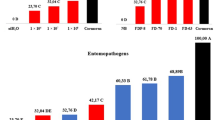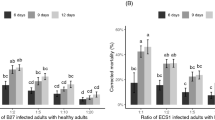Abstract
Sustainable pest management requires the use of ecosystem-friendly control options (e.g. entomopathogens) coupled with target-specific application methods. Here we investigate the susceptibility of the sorghum chafer (Pachnoda interrupta, Olivier) to Metarhizium sp., isolated from dead P. interrupta under field conditions over several years. Target-specific trapping was achieved using Japanese beetle traps or locally made autoinoculation devices, with methyl salicylate or banana as an attractant. Of the attracted and infected beetles, 49% mortality was achieved during October 2005 and 71% during July 2006, while the corresponding mortality in control treatments was 13 and 5%, respectively. We further confirmed that the mortality of the beetles was due to the fungal treatment as 50 and 80% of the dead beetles showed mycosis, respectively. The performance of the pathogen was also investigated in an autodissemination device in 2008 and 2009, where the beetles that were attracted passed through an inoculation chamber. Of the attracted and infected beetles in the autodissemination device, 58.5% (October) and 90.9% (July) were dead within 15 days after treatment. Control mortality was only 3 and 2%, respectively. The potential for horizontal transmission was investigated, where 47% (October) and 59% (July) of the beetles exposed to the pathogen through horizontal transmission were killed. The pathogen was found to be viable for more than 3 days in the field. Our results show that Metarhizium sp. has potential as a biological control agent, and for achieving autodissemination using the target pest as the vector.
Similar content being viewed by others
References
Abbot W. S. (1925) A method of computing the effectiveness of an insecticide. Journal of Economic Entomology 18, 265–267.
Bengtsson J. M., Satya P. C., Wolde-Hawariat Y., Negash M., Seyoum E., Hansson B. S., Schlyter R., Schulz S. and Hillbur Y. (2010) Pheromone-based mating and aggregation in the sorghum chafer, Pachnoda interrupta. Journal of Chemical Ecology 36, 768–777.
Bengtsson J. M., Wolde-Hawariat Y., Khabaish H., Negash M., Jembere B., Seyoum E., Hansson B. S., Larsson M. C. and Hillbur Y. (2009) Field attractants for Pachnoda interrupta (Coleoptera: Scarabaeidae): identification by means of GC-EAD and single sensillum screening. Journal of Chemical Ecology 35, 1063–1076.
Bischoff J. E., Rehner S. A. and Humber R. A. (2009) A multilocus phylogeny of the Metarhizium anisopliae lineage. Mycologia 101, 512–530.
Bugeme D. M., Knapp M., Boga H. I., Wanjoya A. K. and Maniania N. K. (2009) Influence of temperature on virulence of fungal isolates of Metarhizium anisopliae and Beauveria bassiana to the two-spotted spider mite Tetranychus urticae. Mycopathologia 167, 221–227.
Charnley A. K. and Collins S. A. (2007) Entomopatho-genic fungi and their role in pest control, pp. 159–187. In The Mycota IV: Environmental and Microbial Relationships (edited by C. P. Kubicek and I. S. Druzhinina), 2nd edn. Springer-Verlag, Berlin.
Dejen A. and Merene Y. (2014) Ecology and field biology of the sorghum chafer, Pachnoda interrupta (Olivier) (Coleoptera: Scarabaeidae) in Ethiopia. Advances in Entomology 2, 8–13.
Dembilio O., Quesada-Moraga E., Santiago-Alvarez C. and Jacas J. A. (2010) Potential of an indigenous strain of the entomopathogenic fungus Beauveria bassiana as a biological control agent against the red palm weevil, Rhynchophorus ferrugineus. Journal of Invertebrate Pathology 104, 214–221.
Dimbi S., Maniania N. K., Lux S. A. and Mueke J. M. (2004) Effect of constant temperatures on germination, radial growth and virulence of Metarhizium anisopliae to three species of African tephritid fruit flies. BioControl 49, 83–94.
Ekesi S., Dimbi S. and Maniania N. K. (2007) The role of entomopathogenic fungi in the integrated management of fruit flies (Diptera: Tephritidae) with emphasis on species occurring in Africa, pp. 239–274. In Use of Entomopathogenic Fungi in Biological Pest Management (edited by S. Ekesi and N. K. Maniania). Research Sign Post, Kerala, India.
Ekesi S., Maniania N. K. and Ampong-Nyarko K. (1999) Effect of temperature on germination, radial growth and virulence of Metarhizium anisopliae and Beauveria bassiana on Megalurothrips sjostedti. Biocontrol Science and Technology 9, 177–185.
Ekesi S., Maniania N. K., Mohamed S. A. and Lux S. A. (2005) Effect of soil application of different formulations of Metarhizium anisopliae on African tephritid fruit flies and their associated endoparasitoids. Biological Control 35, 83–91.
Fargues J., Ouedraogo A., Goettel M. S. and Lomer C. J. (1997) Effects of temperature, humidity and inoculation method on susceptibility of Schistocerca gregaria to Metarhizium flavoviride. Biocontrol Science and Technology 7, 345–356.
Furlong M. J. and Pell J. K. (2001) Horizontal transmission of entomopathogenic fungi by the diamondback moth. Biological Control 22, 288–299.
Gindin G., Levski S., Glazer I. and Soroker V. (2006) Evaluation of the entomopathogenic fungi Metarhizium anisopliae and Beauveria bassiana against the red palm weevil, Rhynchophorus ferrugineus. Phytoparasitica 34, 370–379.
Grosscurt A. C. (1978) Effects of diflubenzuron on mechanical penetrability, chitin formation and structure of the elytra of Leptinotarsa decemlineata. Journal of Insect Physiology 24, 827–831.
Grunshaw J. P. (1992) Field studies on the biology and economic importance of Pachnoda interrupta (Coleop-tera: Scarabaeidae) in Mali, West Africa. Bulletin of Entomological Research 82, 19–27.
Humber R. A. (1997) Fungi identification, pp. 153–185. In Manual of Techniques in Insect Pathology (edited by L. A. Lacey). Academic Press, San Diego, California.
Inglis D. G., Goettel S. M., Butt T. M. and Strasser H. (2001) Use of hyphomycetes fungi for managing insect pests, pp. 23–69. In Fungi as Biocontrol Agents: Progress, Problems and Potential (edited by T. M. Butt, C. Jackson and N. Magan). CABI International, Wallingford, UK.
Jago N. D. (1995) Population monitoring and crop loss assessment in integrated pest management of panicle pests of sorghum and pearl millet, pp. 103–113. In Panicle Insect Pests of Sorghum and Pearl Millet (edited by O. Youm). ICRISAT, Niamey, Niger.
Jembere B., Getahun D., Negash M. and Seyoum E. (2005) Toxicity of Birbira (Milletia ferruginea) seed crude extracts to some insect pests as compared to other botanical and synthetic insecticides, pp. 88–96. In Proceedings of the 11th NAPRECA Symposium on Natural Products and Drug Delivery, 9–12 August 2005, Antananarivo, Madagascar, edited by J. O. Midiwo, A. Yenesew and S. Derese. A NAPRECA Publication, Nairobi, Kenya.
Klein M. G. and Lacey L. A. (1999) An attractant trap for autodissemination of entomopathogenic fungi into population of the Japanese beetle Popillia japonica (Coleoptera: Scarabaeidae). Biocontrol Science and Technology 9, 151–158.
Krall S., Youm O. and Kogo S. A. (1995) Panicle insect damage and yield loss in pearl millet, pp. 135–145. In Panicle Insect Pests of Sorghum and Pearl Millet (edited by K. F. Nwanze and O. Youm). ICRISAT Sahelian Center, Niamey, Niger.
Lacey L. A., Martins A. and Ribeiro C. (1994) The pathogenicity of Metarhizium anisopliae and Beauveria bassiana for adults of the Japanese beetle, Popillia japonica (Coleoptera: Scarabeidae). European Journal of Entomology 91, 313–319.
Loch C., Mahmoud M. and Sidibe A. (1988) Agricultural Economics Report 1987. Mali Millet Pest Control Project R1521 (R). Natural Resources Institute, Chatham, Kent, UK. 69 pp.
Maniania N. K. and Ekesi S. (2013) The use of entomopathogenic fungi in the control of tsetse flies. Journal of Invertebrate Pathology 112, S83–S88.
Maranga R. O., Hassanali A., Kaaya G. P. and Mueke J. M. (2006) Performance of a prototype baited-trap in attracting and infecting the tick Amblyomma variega-tum (Acari: Ixodidae) in field experiments. Experimental and Applied Acarology 38, 211–218.
Meissle M., Pilz C. and Romeis J. (2009) Susceptibility of Diabrotica virgifera virgifera (Coleoptera: Chrysomelidae) to the entomopathogenic fungus Metarhizium anisopliae when feeding on Bacillus thuringiensis Cry3Bbl-expressing maize. Applied and Environmental Microbiology 75, 3937–3943.
Moore D., Reed M., Le Patourel G., Abraham Y J. and Prior C. (1992) Reduction of feeding by the desert locust, Schistocerca gregaria, after infection with Metarhizium flavoviride. Journal of Invertebrate Pathology 60, 304–307.
Quesada-Moraga E., Martin-Carballo I., Garrido-Jurado I. and Santiago-Álvarez C. (2008) Horizontal transmission of Metarhizium anisopliae among laboratory populations of Ceratitis capitata (Wiedemann) (Diptera: Tephritidae). Biological Control 47, 115–124.
Quesada-Moraga E., Ruiz-García A. and Santiago-Alvarez C. (2006) Laboratory evaluation of entomopathogenic fungi Beauveria bassiana and Metarhizium anisopliae against puparia and adults of Ceratitis capitata (Diptera: Tephritidae). Journal of Economic Entomology 99, 1955–1966.
Ratnadas A. and Ajayi O. (1995) Panicle insect pests of sorghum in West Africa, pp. 29–38. In Panicle Insect Pests of Sorghum and Pearl Millet (edited by K. F. Nwanze and O. Youm). ICRISAT Sahelian Center, Niamey, Niger.
Roberts D. W. and St Leger R. J. (2004) Metarhizium spp., cosmopolitan insect pathogenic fungi: mycological aspects. Advances in Applied Microbiology 54, 1–70.
Sastawa B. M. and Lale N. E. S. (2000) Efficacy of host plant resistance, sowing date modification and intercropping as methods for the control of Pachnoda interrupta (Olivier) in pearl millet in the Nigerian Sudan savanna. Journal of Arid Environments 46, 249–262.
Seneshaw A. and Mulugeta N. (2002) Study on the biology of sorghum chafer, Pachnoda interrupta (Coleoptera: Scarabaeidae) under laboratory condition. Pest Management Journal of Ethiopia 6, 31–36.
Seyoum E., Moore D. and Charnley A. K. (1995) Reduction in flight activity and food consumption by the desert locust, Schistocerca gregaria, after infection with Metarhizium flavoviride. Journal of Applied Entomology 118, 310–315.
Seyoum E. and Negash M. (2007) The performance of Metarhizium anisopliae var. acridum against mixed grasshopper spp. under Ethiopia field conditions. SINET: Ethiopian Journal of Science and Technology 30, 55–64.
Tefera T. and Pringle K. (2003) Germination, radial growth, and sporulation of Beauveria bassiana to Chilo partellus (Lepidoptera: Pyralidae) at different temperatures. Biocontrol Science and Technology 13, 699–704.
Toledo J., Campos S. E., Flores S., Liedo P., Barrera J. E., Villasenor A. and Montoya P. (2007) Horizontal transmission of Beauveria bassiana in Anastrepha ludens (Diptera: Tephritidae) under laboratory and field cage conditions. Journal of Economic Entomology 100, 291–297.
Wolde-Hawariat Y., Seyoum E., Jembere B., Negash M., Hansson B. S. and Hillbur Y. (2007) Behavioural and electrophysiological response of sorghum chafer Pachnoda interrupta (Coleoptera: Scarabaeidae) to plant compounds. International Journal of Tropical Insect Science 27, 53–61.
Author information
Authors and Affiliations
Corresponding author
Rights and permissions
About this article
Cite this article
Getahun, M.N., Biasazin, T.D., Wolde-Hawariat, Y. et al. Metarhizium sp. isolated from dead Pachnoda interrupta (Coleoptera: Scarabaeidae) as a potential entomopathogenic fungus for the pest insect: proof-of-concept for autodissemination. Int J Trop Insect Sci 36, 1–9 (2016). https://doi.org/10.1017/S1742758415000235
Accepted:
Published:
Issue Date:
DOI: https://doi.org/10.1017/S1742758415000235




